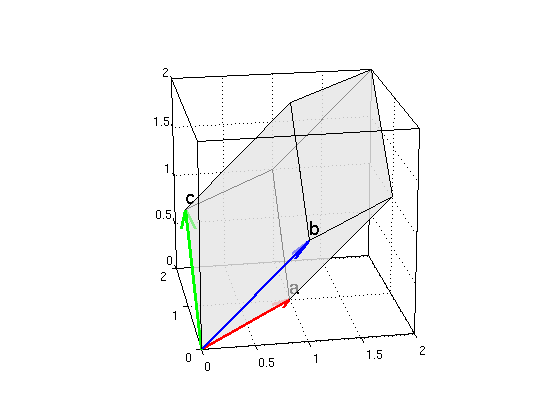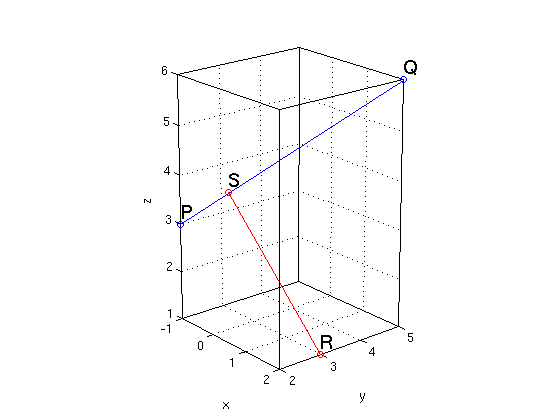Examples Monday, Febr. 3
Contents
Volume of parallelepiped
A parallepiped has a vertex (0,0,0) and vectors a = (1,1,0), b=(1,0,1), c = (0,1,1). Find the volume and plot the parallelepiped.
a = [1,1,0]; b = [1,0,1]; c = [0,1,1]; determinant = det([a;b;c]) % note that vectors a,b,c have negative orientation volume = abs(determinant) gray = [.9 .9 .9]; parallelepip([a;b;c],gray); alpha(0.6) % make transparent nice3d; hold on or = [0,0,0]; arrow3(or,a,'r'); texts(a,'a'); arrow3(or,b,'b'); texts(b,'b'); arrow3(or,c,'g'); texts(c,'c'); hold off view(-10,20) % pick nice angle to look at plot
determinant =
-2
volume =
2

Distance of point to line
Consider the line through the points P = (-1,2,3) and Q = (2,5,6). For the point R = (2,3,1) find the closest point S on the line. Find the distance of the points R and S.
Then compute the distance of the point R to the line using the formula with the cross product and check that you get the same value.
Make a graph which shows the line and the points P,Q,R,S.
P = [-1,2,3]; Q = [2,5,6]; R = [2,3,1] L = Q - P % direction vector L of line d = R - P % vector from P to R dpar = dot(L,d)/dot(L,L)*L % projection of d onto L S = P + dpar % S is closest point to R distance1 = norm(R-S) % Method 1: distance of points R,S distance2 = norm(cross(L,d))/norm(L) % Method 2: formula with cross product plotpts([P;Q],'o-'); % plot line thru P,Q, mark pts with 'o' hold on % add to the current plot plotpts([R;S],'ro-'); % plot points R,S (connected by red line) texts(P,'P'); texts(Q,'Q'); % label points texts(R,'R'); texts(S,'S'); hold off; nice3d view(50,20); % pick nice angle to look at plot
R =
2 3 1
L =
3 3 3
d =
3 1 -2
dpar =
0.6667 0.6667 0.6667
S =
-0.3333 2.6667 3.6667
distance1 =
3.5590
distance2 =
3.5590
